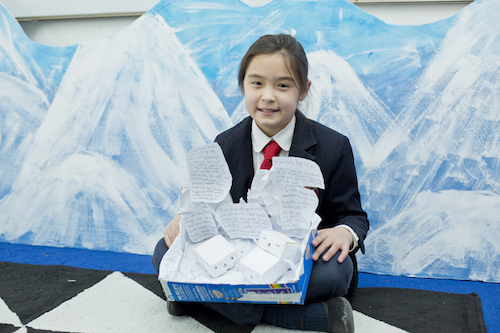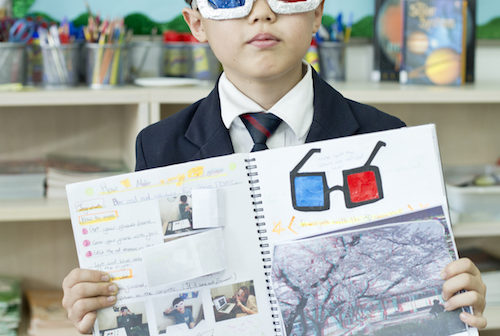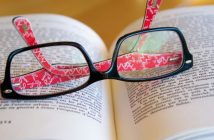The best educators strive to give their homework assignments more depth. But young Tommy is able, entirely on his own, to give one of his assignments that added dimension in every sense of the word. The nine-year-old Korean student, enrolled in Year 5 at Dulwich College Beijing (DCB), designed and made his own 3D glasses and pictures for a recent project, so that it had a literally immersive quality.
The project capped off his class’s “Spectrum” topic. These topics are spread across numerous subjects, and give the students a more holistic education, leading DCB to call the junior school program a “creative curriculum.” One of the topics, for instance, was dubbed “Bean to Bar” and covered the scientific process of making chocolate, the social aspects of fair trade, the biological facets of how cocoa is both grown and digested, and more, so that each of the students’ classes helped them gain a well rounded understanding of the issue.
Dan Nichol, DCB’s Deputy Head of Junior School, says these broader topics are a more innovative alternative to the rigid— and frequently disparate— text book units assigned in conventional classrooms. “When students have to chop and change between their History, Science and Geography lessons, then their minds have to keep jumping,” he says, adding: “When young minds are already growing anyway, having the consistency of our creative curriculum allows the teachers to move their learning a lot more than if they were jumping between subjects.”
Below Dan Nichol, along with Tommy and several other DCB junior school students, tell us more about the breadth and depth of this uniquely beneficial curricular approach.

Tommy, Year 5, Aged nine
I researched how to make 3D glasses, got some red and blue cellophane and glued it all together. Then I printed some 3D pictures. I was amazed when I put the glasses on, and could see the pictures in 3D.
We did another topic about space, and learned all about Albert Einstein, Stephen Hawking, black holes, wormholes and more. I also really enjoyed learning about all of that.

Audrey, Year 3, Aged eight
My favorite was the topic about plants. We learned about how plants use water, how they have these little holes in them that absorb water up, and then we sang a song about CO2.
I also got to draw how a plant works. I love to do work with art, rather than boring old ways of studying.

Sydney, Year 4, Aged eight
I enjoyed our topic about climate change, and how to save the arctic. It was fun because we made paper snowflakes in an art project, and did some creative writing about animals and water.

Maeve, Year 6, Aged 11
We just finished our “Disaster Strikes” topic. It allowed me to do some suspense writing. Then we described Atlantis for a poetry assignment. After that we did an investigation on how rust works, which was fun.
I get bored a lot at home. But never at school. It feels like we’re always working on something really interesting.

Daniel Nichol, British, DCB Deputy Head of Junior School
For us homework is about helping students find the drive to learn about what they love. It shouldn’t be a chore, instead it should leave them saying: “Yes, I want to do this because I’m passionate about it.”
There’s a wide range to both the topics and the assignments. Each Year 4 student recently made a sponge cake in the shape of the continent of Africa for a geography assignment. So they weren’t only learning about geography, but also how to measure and mix ingredients. It’s very important for us to have those creative elements in the curriculum, and not base everything on academic excellence. We have a proven track record of academic achievement. But if you want to have well rounded learners, who use their imaginations and think critically, then that is what the homework lets them do.
We started with the British curriculum, then broadened it out with other bits from other cultures including America, Singapore and more. And we’ll continue to incorporate more as we go. Our creative curriculum is in its third year now, and it’s continually changing, never static or stagnant.
All of this opens kids eyes to the world more, and gives them the skill set to think outside box. Many of these students are very fortunate, have ayis and are looked after well. Our creative curriculum gives them tools and shows them a differing mindset to be independent, dynamic, and robust thinkers, rather than being complacent and thinking: “It’ll be okay, everything is going to be handed to me.”
 This is the sixth in a series of posts brought to you by Dulwich College Beijing. DCB is made up of over 1430 students from age one to 18, with over forty-five nationalities represented in its diverse student body. It is a British international school, offering an educational environment designed to nurture not only the intellectual and physical but also social and emotional development of students. The school takes pride in an excellent pastoral care programme, as well as superb IB results. The school’s creative curriculum, offered in the Junior School, is just one its many strengths.
This is the sixth in a series of posts brought to you by Dulwich College Beijing. DCB is made up of over 1430 students from age one to 18, with over forty-five nationalities represented in its diverse student body. It is a British international school, offering an educational environment designed to nurture not only the intellectual and physical but also social and emotional development of students. The school takes pride in an excellent pastoral care programme, as well as superb IB results. The school’s creative curriculum, offered in the Junior School, is just one its many strengths.
Photos: Uni You




